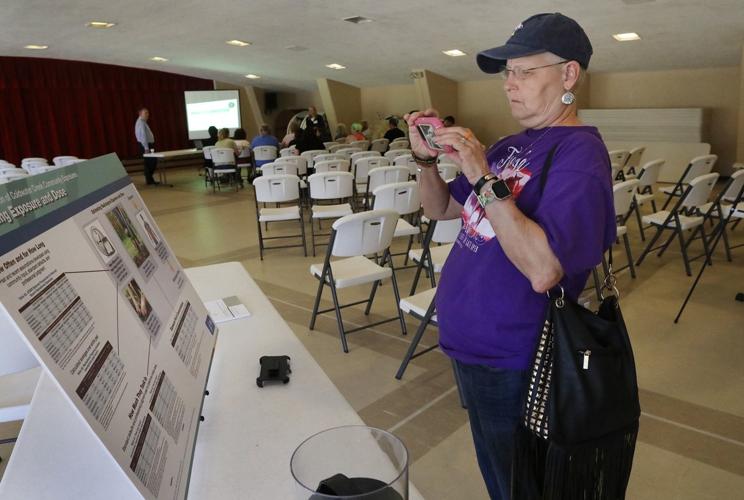FLORISSANT ŌĆó A group of federal scientists addressed a packed crowd on Wednesday to explain a that shows some people may have an increased risk of developing certain cancers if they lived or played near Coldwater Creek from the 1960s through the 1990s.
Some of the people who attended expressed mixed feelings about what to do now that an increased risk for some cancers has been established.
The scientists with the Agency for Toxic Substances and Disease Registry said those who may have been exposed should not postpone medical care if they start to notice changes in their health and should tell their primary care physician about their possible exposure.
People are also reading…
ŌĆ£What are we going to do with this information now that we have it?ŌĆØ asked Laura Shroeder, who grew up in Florissant and whose sister recently died of lung cancer. ŌĆ£These people need something and they need a lot more than ŌĆśCall your primary care physician.ŌĆÖŌĆØ
But a longtime leader of the volunteer group that pushed for the federal study, Kim Visintine, a native of Florissant, said this is a critical first step.
ŌĆ£This is kind of like the golden ticket,ŌĆØ Visintine said. ŌĆ£ItŌĆÖs the key that opens the door to all these other opportunities to other resources.ŌĆØ
The group, Coldwater Creek ŌĆö Just the Facts, hopes to use the study to pressure federal lawmakers to include them in the Radiation Exposure Compensation Act, which could mean access to restitution and money for educational efforts and health screenings.
Coldwater Creek was contaminated decades ago by nuclear waste from the production of weapons during World War II. The waste was stored at sites near ├█č┐┤½├Į Lambert International Airport, adjacent to the creek that flows from St. Ann to the Missouri River.
Missouri health officials asked for federal assistance after a state report in 2014 showed high rates of leukemia, breast, colon and other cancers in the areas surrounding the creek. In 2016, the toxic substances agency, which is part of the U.S. Centers for Disease Control and Prevention, launched a study into a potential link between the creekŌĆÖs contamination and cancer cases in current and former residents of the area.
The agencyŌĆÖs report, released June 18, shows there could be an increased risk for certain cancers, including leukemia, bone and lung cancers, and smaller risk of developing skin and breast cancers for those who lived near the creek from the 1960s through the 1990s. It said anyone who has lived near the creek since 2000 is thought to have lower levels of radiation exposure but still have a potentially higher risk of bone or lung cancer.
Kathryn Ward, who attended the public meeting about the report Wednesday at St. MarkŌĆÖs United Methodist Church in Florissant, was diagnosed with leukemia in September. Coldwater Creek was immediately behind her childhood home. Now she wonders if it contributed to her cancer diagnosis.
ŌĆ£IŌĆÖve been healthy my whole life and now IŌĆÖm on my deathbed,ŌĆØ Ward said.
Ward said life was different when she grew up. Kids played in the creek and spent many hours outside.
ŌĆ£We had to come home when the street lights came on,ŌĆØ she said.
She retired just months before her diagnosis and now spends considerable time commuting from Fayette, Mo., to Barnes-Jewish Hospital in ├█č┐┤½├Į to receive care.
She said she feels blessed to have health insurance as she fights the disease.
Dorlita Adams is a breast cancer survivor who got a clean bill of health in March. She has lived and worked in North County since 1997 and wants to move, fearful of what her home might contain.
Besides calling her doctors, she wants to know what comes next for residents.
In the meantime, she believes signs should go up around the creek to warn residents of the potential hazard.
That could happen soon.
On Tuesday night, the ├█č┐┤½├Į County Council asked lawyers for the county to write an ordinance that would comply with the U.S. Department of Health and Human Services recommendation to place signs to inform residents and visitors of potential exposure risk in areas around Coldwater Creek. The ordinance would be introduced in July; there were no specific plans yet on record.
The creekŌĆÖs contamination has gotten increased attention in recent years as residents have also urged a cleanup of West Lake Landfill in Bridgeton, where some of the radioactive waste was dumped in 1973.
Jeremy Kohler of the Post-Dispatch contributed to this report.











